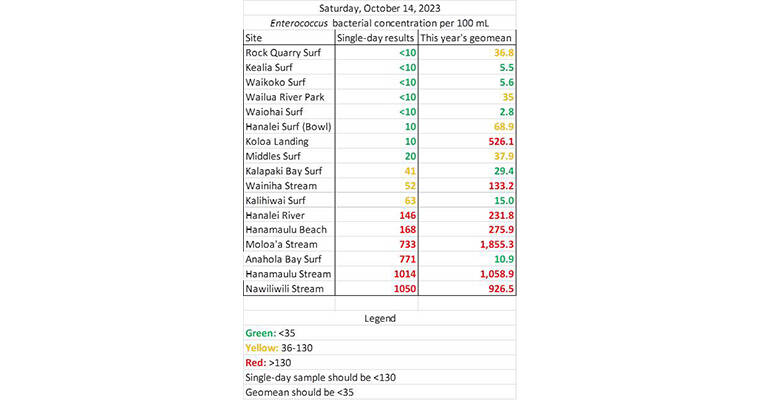LIHU’E — A scientist at the Surfrider Foundation’s Kaua‘i Chapter has released the organization’s monthly results of pollution levels at different streams, rivers and surf spots around the island, and about one-third of the sites tested showed a high presence of bacteria.
The Surfrider Kaua‘i’s Blue Water Task Force samples 18 different locations around the island on the second Saturday of every month to check the levels of enterococcus, a bacteria indicating the presence of fecal matter in the water.
“We sample at the mouths of streams because we know that all the babies and kids play there,” said Carl Berg, a senior scientist with the Surfrider Foundation’s Kaua‘i Chapter, who noted they also test areas frequented by swimmers, paddleboarders and surfers.
During the most recent test on Oct. 14, Berg stated there was “little surface or groundwater contamination” at surf sites due to drought conditions, but the streams and the waters discharging into the ocean showed contamination.
“Concentrations of bacteria in Nawiliwili Stream and Hanama‘ulu Stream are approximately eight times the Hawai‘i state rules and along with other mean values, highlighted in red in the table, indicate that those waters are chronically polluted,” Berg said.
Sites marked as green due to low levels of an enterococcus bacterial concentration, less than 35 per 100 ml, were Rock Quarry Surf, Kealia Surf, Waikoko Surf, Wailua River Park, Waiohai Surf, Hanalei Surf (the Bowl), Middles Surf and Koloa Landing.
Notably, Koloa Landing had a bacteria level of 10 per 100 ml, significantly lower than its average of 526.1 per 100 ml.
Sites marked as yellow, with a bacterial concentration between 36-130 per 100 ml were Kalapaki Bay Surf, Wainiha Surf and Kalihiwai Surf.
Sites analyzed to be more polluted were listed in red and had enterococcus concentrations between 146 to 1050 per 100 ml.
Those sites were Hanalei River, Hanama‘ulu Beach, Moloa’a Stream, Anahola Bay Surf, Hanama‘ulu Stream and Nawiliwili Steam.
Notably, the concentration of enterococcus analyzed at Anahola Bay Surf increased to 771 per 100 ml, over 70 times higher than its average this year of 10.9.
“Stay out of those waters and Surfrider advises that you rinse off with fresh water whenever you get out of the streams or ocean,” Berg said.
“If the water is brown from recent rain, it most certainly is polluted. Follow the DOH’s Brown Water Advisories and stay out,” he added.
The contamination is coming from the island’s approximately 14,000 cesspools, which release untreated sewage and other waste into nearby soil, contaminate groundwater and seep into the island’s streams and beaches.
“It’s all coming from cesspools,” said Berg of the contaminated sites.
He pointed out the pollution sparked the state Legislature to initiate its cesspool replacement program in 2017 by passing Act 125, which requires all 88,000 of the state’s cesspools to be replaced by an alternative system to reduce pollution.
“The state government said, ‘We got to stop this. Our waters are polluted and we (have) to stop it because it’s a public health risk. People are getting sick all the time,’” Berg said.
The state is requiring all cesspools to be converted to septic systems by 2050.
Berg is advocating for sites found to be highly polluted, especially Koloa Landing and Nawiliwili Stream, to have warning signs put up so people are aware of the potential health risks.
He noted being in a “20-year battle with the DOH” to get a sign put up at the Nawiliwili Stream.
“The county took it down and would not let us put it up again,” he said. “Nawiliwili Stream has human sewage in it.”
Berg was critical of the DOH, saying they are reticent to put up signs in certain places. He noted they do their own water samples of major beaches around the island.
“They like to sample places that are always clean, so they can say they’re doing such a good job,” he said. “That’s where Surfrider has … gone up and put up our own signs.”
The DOH did not immediately respond to The Garden Island’s request for comment.
•••
Emma Grunwald, reporter, can be reached 808-652-0638 or egrunwald@thegardenisland.com.



It seems almost criminal not to post warning signs at known polluted areas. Is this public health?